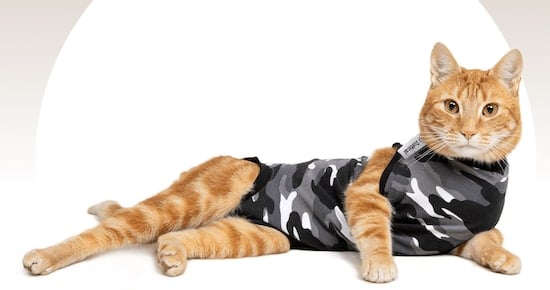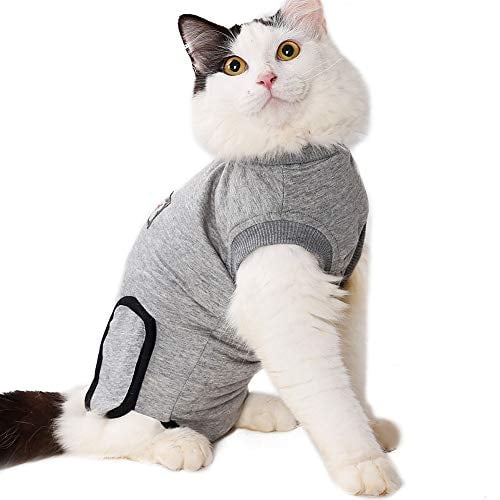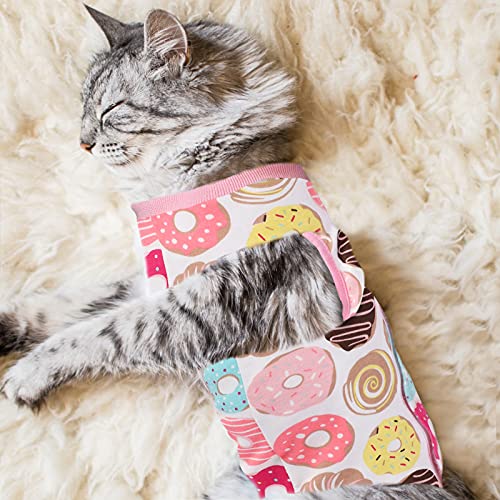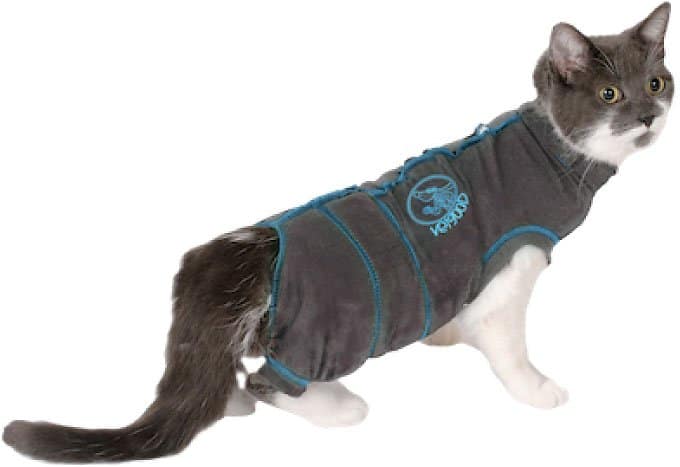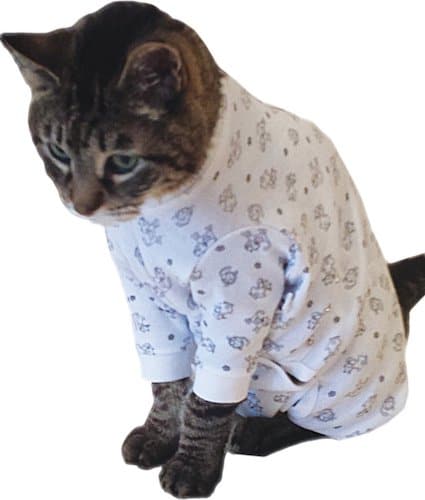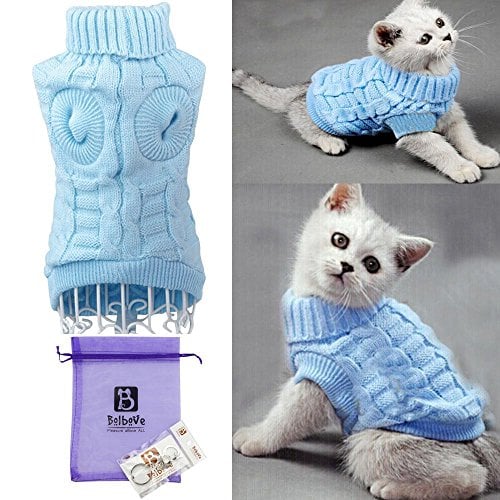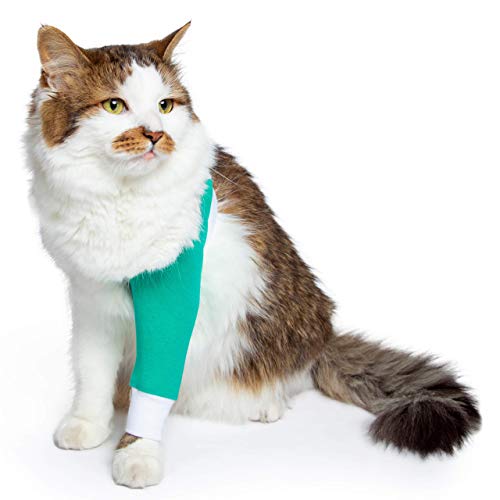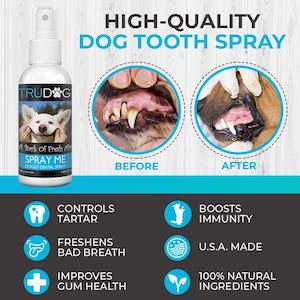- This post contains affiliate links. Read more here.
- Not a substitute for professional veterinary help.
Surgery is stressful enough for your cat without the discomfort of a stiff plastic “cone of shame.” Fortunately, there are other options for a kitty recovering from surgery or being treated for a wound or skin condition, including soft collars, padded collars, and cat recovery suits. Consider all the options—and talk with your veterinarian—so you’ll be ready when your kitty comes home.
When Your Cat Needs a Recovery Suit
As much as your cat may try to convince you otherwise, they must wear a recovery suit or an Elizabethan collar whenever the vet orders it. Veterinarian John Berg, Professor of Small Animal Surgery at the Cummings School of Veterinary Medicine at Tufts, says there’s no truth to the belief that cats can heal themselves by licking a wound. In fact, any incision or treated area needs to be protected from licking (and clawing). You can do that by fitting your cat with the right E-collar or recovery suit.
When do you choose an E-collar and when do you go for a recovery suit? That’s based on the location of the injury or incision. To protect a cat’s face, you’ll want an E-collar. But if the wound or irritated area is on the kitty’s torso, the recovery suit might be the best choice. Suits are designed to fully cover a wound or irritated area on the torso, preventing your cat from pulling out stitches, chewing on irritated skin, licking at medication, or removing dressings. In most cases, your cat will enjoy full mobility and will be able to eat, drink, and use the litter box while wearing the suit.
As always, talk with your veterinarian about the best way to protect your kitty during recovery.
Recovery Suits for Cats
While Elizabethan collars are designed to reduce a cat’s range of motion so they can’t reach a surgical site or injured area, recovery suits take the opposite approach. They allow the cat to move freely but protect the injured or irritated area from teeth, claws, and tongues. Some recovery suits can also be used to hold dressings in place.
One tip offered by recovery suit manufacturers is to give your cat time to adjust. If your cat hasn’t worn a recovery suit, costume, or harness before, their first reaction might be to lay down and refuse to move. This seems to be instinctive. Most cats will soon get used to the recovery suit and resume moving around as usual—so don’t panic if your kitty’s first response is to hunker down and stay still.
This suit gets rave reviews from cat parents for its effectiveness at preventing cats from fussing with their surgical wounds. There is a detailed sizing guide and calculator on the Suitical website with measuring directions to help you find the best fit (cat sizes include XXX-small, XX-small, X-small, and small). A blue lining makes it easy to detect fluids or bleeding, and there is a pocket that will hold an ice pack or absorbent padding. The suit closes with snaps, and stretchy neck and leg openings offer maximum mobility while keeping everything in place. The manufacturer says that most cats will be able to use the litter box without dirtying the suit.
This affordable recovery suit is made of a light, soft, breathable cotton/Lycra knit so your cat can easily move around. Sizes range from Extra Extra Small for kittens to Medium for cats more than 11 pounds.
If keeping your kitty clean during recovery is an issue, this set of four colorful suits made of stretchy cotton knit may be the answer. These suits come in three sizes (S, M, L), but the manufacturer cautions that they are for kittens and cats up to 10 pounds (no larger).
This recovery suit for wound management and post-surgical protection is a two-piece. You put the top on over the head, roll it down to the shoulders, and insert the cat’s front legs one at a time. The optional back piece is like a pair of undies. The machine-washable suit is 95% cotton and 5% Lycra and attaches with Velcro. Be sure to read the sizing instructions before ordering—based on reviews, several purchasers suggest sizing up if in doubt.
This lightweight step-in onesie is, like other suits, designed to prevent your pet from licking, biting, or scratching at a sensitive area. However, unlike other recovery suits, it covers the upper legs—so it could be ideal for a cat recovering from a leg or shoulder condition. The chest and tummy area is adjustable for a snug fit, and most cats can easily use the litterbox while wearing the suit. Made of Pima cotton, the pullover is machine washable.
If your cat’s sensitive area is on the shoulder or back, you may be able to get away with a simple pet sweater, such as this one. The acrylic sweater, available in five sizes, is machine washable.
But wait—there’s more. If the affected area you are trying to protect is a shoulder or foreleg, your cat does not need to wear a full recovery suit. You may be able to use this snug-fitting protective sleeve that ties securely around the back and chest. The XS and S sizes are designed for cats.
Homemade Recovery Outfit Solutions
Need to improvise a recovery collar or suit for your cat in a hurry? A baby T-shirt or onesie will often do the trick. This vet in England posted an entire gallery of cat patients wearing their collars and tiny shirts.
Another popular recovery outfit solution for kittens and small cats is making a “cat sweater” out of socks. If you’re the DIY type—and if your vet approves—give this economical option a go.
Further Reading


